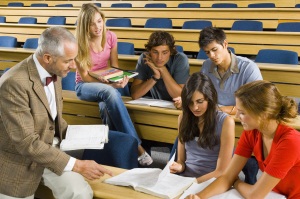What is Reciprocal Teaching?
Posted by PLB Blogger · Leave a Comment

 Palinesar and Brown (1984) described Reciprocal Teaching as an instructional strategy that is “a dialogue between teachers and students for the purpose of jointly constructing the meaning of the text.” In this strategy, the role of “a teacher” is shared by both teacher and student, as they take turns in leading the discussion regarding the given reading portion.
Palinesar and Brown (1984) described Reciprocal Teaching as an instructional strategy that is “a dialogue between teachers and students for the purpose of jointly constructing the meaning of the text.” In this strategy, the role of “a teacher” is shared by both teacher and student, as they take turns in leading the discussion regarding the given reading portion.
It aims to improve a student’s reading comprehension, by instructing the student in the four key reading strategies: Summarizing, Questioning, Clarifying and Predicting. Reciprocal teaching stimulates students to explore deep into the text material, to ask questions and formulate opinions, to critically analyze the information and to generate ideas.
Reciprocal teaching instruction includes scaffolding and thinking aloud. Each strategy is first taught and modeled by the teacher. Next, the teacher must ensure that the students understand the new strategy before proceeding to the next one. Teachers act as coaches while the procedures (summarizing, questioning, clarifying, predicting) are being practiced by the students. As students work, the teachers provide timely feedback. When students master the steps, the leadership is handed over to the students and teacher’s support is gradually withdrawn.
The strategy can be incorporated either as a whole class activity (opening or closure activity) or a small group activity, each group comprising not more than 6 students. Small group activities have found to be more beneficial for students who are introverts, inattentive or with other individual needs, as small groups encourage opening up and participation.
To begin with, the text is read aloud by the teacher and he models how to summarize the information in the form of “think aloud.” The teacher can use the “what, why, when, who and where?” questions to model the process of summarizing and also use the same to lead the discussion for questioning the content. Students can respond and ask additional questions and re-read the material in case of a disagreement. The purpose of these strategies is to gain an understanding of the material. The next step is to clarify information like meaning of new words, concepts etc.
Predicting the material can be used either as a first step (to use the illustrations, titles, subtitles etc to predict what the text is about) or as a last step (what will follow the material that has been read). As a first step, the teacher can make few predictions which are then validated while reading through the text. Prediction as a conclusion requires the individual to use the clues within the text to make future predictions regarding the content.
Additional activities like providing identities for members ( students are allotted individual roles that of a reader, summarizer, questioner and can take turns leading each identity) or using interactive tools like blackboards and graphic organizers to write down headings and points for summarizing, questioning, predicting etc makes the learning more interactive and thought provoking for the students.
Thus, through Reciprocal teaching students are encouraged to develop skills of self regulation, monitoring and intentional learning.
Discuss here: What are the factors to consider for diminishing our assistance and for making learning more student-centered?
Learn more: Take a course



